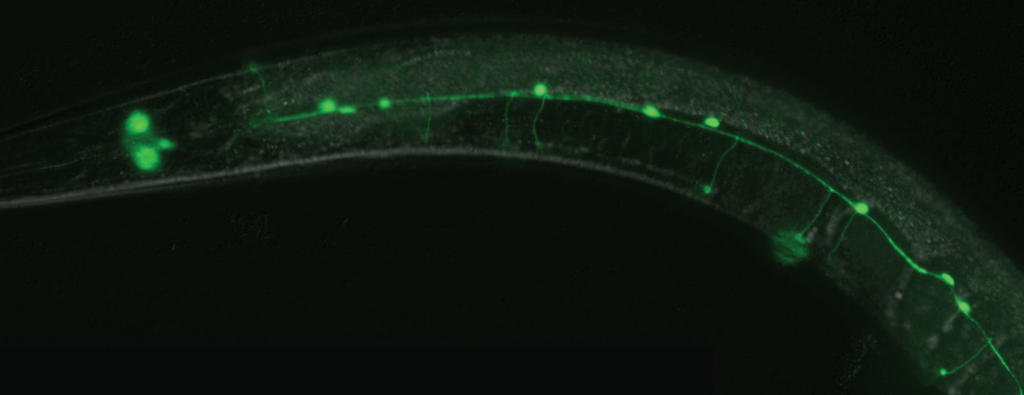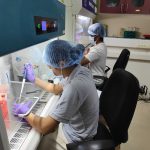Kavita Babu’s lab is investigating the molecular mechanisms that underpin animal movement

Before her passing, Veronica Rodrigues, one of India’s most well-known neurobiologists, mentored dozens of students — not just her own but also several undergraduate students from around the country who spent their summers in her lab at the Tata Institute of Fundamental Research (TIFR), Mumbai. In 1996, Kavita Babu was one of them.
Kavita was then a BSc student at St Joseph’s College, Bangalore, majoring in Physics, Chemistry, and Mathematics. “I really enjoyed the summer there, working on fruit fly biology, especially the genetics,” she recalls. The experience had such a profound influence on her that she decided to become a biologist.
After her undergraduate degree, Kavita joined a Master’s programme in biotechnology. At that time, on the advice of Rodrigues, she talked to William Chia, a fruit fly biologist at the Institute of Molecular and Cellular Biology in Singapore, about the possibility of working with him. After her first year, she left her Master’s programme and went on to do her PhD with Chia in developmental biology. But her love for genetics and neurobiology, which she was exposed to in Rodrigues’ lab, eventually led her to pursue neurogenetics for her postdoctoral research at the Massachusetts General Hospital in the United States.
In 2011, Kavita moved back to India as a faculty member at the Indian Institute of Science Education and Research (IISER), Mohali, where she set up her own lab. But after having spent more than seven years up north, she wanted to come back to South India, and so applied to IISc. And in 2019, she joined the Centre for Neuroscience (CNS) at IISc as an associate professor.
At CNS, Kavita’s lab studies a tiny, free living roundworm called Caenorhabditis elegans, better known as C. elegans. Because it has a relatively simple bodyplan and is transparent, it has become an important animal model for biological studies.

There’s another good reason why biologists like Kavita are fond of C. elegans: the invertebrate has about 20,000 genes (compared to about 25,000 in humans), many of which are “conserved”, she says. Understanding conserved genes and the proteins they code for — those that have not changed over the course of evolution — allows researchers to draw conclusions about the origin and evolution of biological traits.
Kavita is interested in understanding the neurogenetics underlying how these worms move. “I don’t know if you have seen a worm moving. It is essentially a sinusoidal movement like in a snake,” she explains. “What are the molecular mechanisms that allow this worm to move as it does? Allow it to stop as it does? Allow it to move backwards? Make turns?” In order to understand the mechanism of locomotion, her lab is addressing two broad questions.
The first is how neurons communicate with each other to facilitate movement. To answer this question, she and her students are studying the role of small proteins called neuropeptides sent out by neurons during signalling.
The second question that intrigues Kavita is how neurons communicate with muscle cells. She believes that the answer to this question might lie in the role of specific molecules at the synapse — the chemical junction between two neurons and between a neuron and a muscle cell — called cell adhesion molecules. She also wants to know whether these molecules have other functions in the pre- and post-synaptic phases of signal transmission required for muscles to contract. In her quest to understand animal locomotion, Kavita and her students have made several significant discoveries. For instance, her PhD student Shruti Thapliyal has shown that a cell adhesion molecule called CASY-1 signals at the neuromuscular junction and is required for the release of GABA, an inhibitory neurotransmitter.
Two of her other students, Pallavi Sharma and Vina Tikiyani, have worked on a set of molecules called claudins that are present on the outermost layer of cells of an organism. When claudins are disrupted, it leads to disruption of these layers, sometimes leading to cancer. “We wanted to look at whether claudins are expressed in neurons and whether they actually function in neurons,” states Kavita. Their research has characterised two claudins, both of which are expressed in neurons and present at the synapse. “These claudins,” she continues, “are required to maintain post-synaptic receptors at the neuromuscular junction.”
For her research contributions, Kavita has already received several awards like the Janaki Ammal National Women Bioscientist Award and Innovative Young Biotechnologist Award. She is happy with the recognition that has come her way but is quick to point out that science is a team sport. “It is important to realise that at the end of the day the awards were won not only because of my work, but because I have a fantastic set of people working with me in the lab.”







